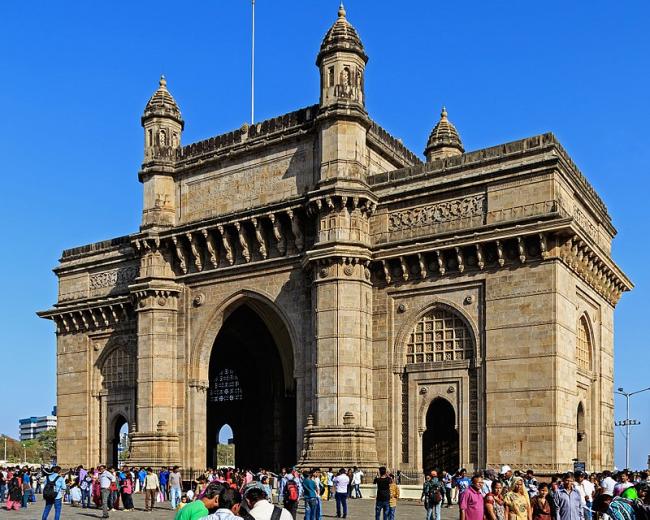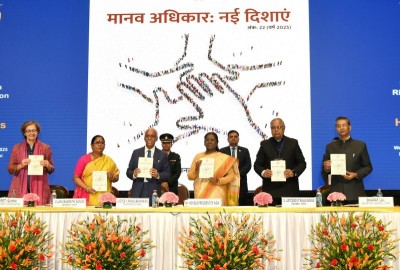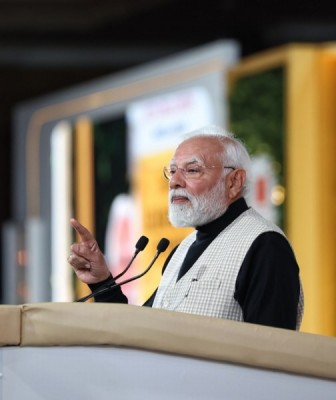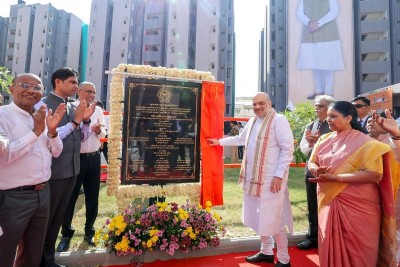
Maharashtra: Unrelenting Reverses
On February 22, 2018, cadres belonging to the Kasansur Local Organizational Squad (LOS) of the Communist Party of India-Maoist (CPI-Maoist) in South Gadchiroli, killed Police Warden (patil) Katiya Peka Pungati (Kumoti) (55), branding him to be a ‘Police Informer’, outside Lanji village in Etapalli Taluka (revenue unit) in Gadchiroli District. Pungati was abducted on February 21 and his body was found with his throat slit, and the face and head smashed with a stone, outside Lanji village. The Kasansur Dalam (armed squad), led by ‘commander’ Mahesh Gota, claimed that they held Pungati responsible for the information of their presence in Tadapalli Forest in Etapalli on January 10, 2018.
On February 5, 2018, a CPI-Maoist cadre was killed in an encounter with the Police in a forest area in the Etapalli area in Gadchiroli District, during the day-long bandh (general shutdown) called by Maoists in the Dandakaranya region. An 8 mm rifle and articles of daily use were recovered from the encounter spot. The identity of the slain Maoist is yet to be ascertained.
On January 31, 2018, a three-member action team of the CPI-Maoist killed Irpa Usendi, a cousin of the ‘Divisional Committee Member (DVCM)’ and ‘commander’ of Perimili Local Guerrilla Squad (LGS), Sainath, at a busy weekly market in Etapalli Taluka in Gadchiroli District. Usendi was one of the accused in the case of arson at the site of the Surjagarh mining project of Lloyds’ Mining and Energy Limited, where 80 vehicles were set ablaze by the Maoists on December 30, 2016. The rebels had strewn pamphlets over the body in which they had labelled him as 'Police informer'.
On January 10, 2018, a Quick Response Team (QRT) of the Gadchiroli Police killed a CPI-Maoist cadre in an encounter in the Tadapalli Forest area in Gadchiroli District. Police recovered a .303 rifle and four cartridges from the spot. The deceased Maoist is yet to be identified.
Thus far, at least four killings, including one Security Force (SF) trooper, and three Maoists, has been killed in LWE-linked violence in Maharashtra since the beginning of 2018 (till March 18, 2018), according to partial data collated by the South Asia Terrorism Portal (SATP). During the corresponding period of the previous year (2017), the State accounted for the same number of killings, including three civilians, and one Maoist.
Through 2017, 25 persons, including seven civilians, three SF personnel and 15 Maoists, were killed in 17 incidents, as compared to 26 such fatalities, including 12 civilians, two SF personnel and 12 Maoists in 21 incidents of killing in 2016, according to SATP.
An analysis of fatalities clearly indicates that the civilian population is safer today than was the case a few years ago. In terms of civilian fatalities, Maoist violence in the State was at its peak in 2011, when 34 civilians were killed. A low of two fatalities in this category was recorded twice, in 2005 and 2008. Civilian fatalities in 2011 were also the highest ever deaths registered in this category in the State since the formation of the CPI-Maoist on September 21, 2004. After a decline between 2012 and 2014, civilian fatalities started to rise in 2015, though the increase was marginal. Significantly, there is no fatality recorded in this category, thus far, (data till March 18, 2018) in the current year.
Meanwhile, after registering a decline between 2014 and 2016, SF fatalities spiked marginally, from two in 2016 to three in 2017. The kill ratio was in favour of the Maoists in 2014 and 2015, at 1.1:1 and 2:1, respectively. However, SFs secured a positive kill ratio of 1:6 in 2016, and 1:5 in 2017.
The number of major incidents (each resulting in three or more fatalities) in 2017 was restricted to just one, as compared to two in 2016. On December 6, 2017, seven CPI-Maoist cadres were killed in an encounter near Kalled village in the Sironcha tehsil of Gadchiroli District.
Union Ministry of Home Affairs (UMHA) data confirmed this declining trend in Maoist activities on the ground. Maharashtra registered 69 Maoist-linked incidents through 2017, as against 73 such incidents in 2016.
Geographically, all fatalities, indeed, all Maoist violence in 2016 and 2017, remained confined to Gadchiroli, the epicenter of Maoist activities. Unsurprisingly, UMHA identified Gadchiroli as one among 35 ‘worst LWE affected Districts’ across seven States in the country.
According to SATP data, at least 11 Maoists were arrested in Maharashtra in 2017, in addition to two arrests in 2016. The most significant catches of 2017 included Chandrika Jethuram Raut (42), a member of the Chamorshi dalam and carrying a reward of INR 200,000 on his head, who was arrested by the Police in Gadchiroli District on December 31. On June 17, 2017, SFs arrested Pawan aka Soma Phoda Weladi (35), a member of the Maoists’ Gariabandh ‘divisional committee’, carrying a reward of INR 1.6 million, in Gadchiroli District. Pawan had been involved in several acts of violence in Maharashtra, Chhattisgarh and Odisha over the preceding 20 years and also worked as a bodyguard for senior Maoist leaders.
Mounting SFs pressure also led to the surrender of 11 Maoists in 2017, adding to 34 such surrenders reported in 2016. Significantly, on December 7, 2017, two prominent Maoists, identified as Kamla Gavle and Nagesh Madavi, each of them carrying a reward of INR 200,000, surrendered before the Gadchiroli Police. In the interim, terming the Aatmasamarpan (surrender) scheme a successful weapon against the Naxalites [Left-Wing Extremists (LWEs)], the Maharashtra Government extended the scheme for another two years, till August 28, 2019. The Naxalite [Left-Wing Extremism (LWE)] surrender scheme was introduced in August 29, 2005, with the aim of rehabilitating and absorbing the ultras into the mainstream of society. According to a report dated October 6, 2015, the State Government disclosed that during the 10 years for which the program had been in place, at least 502 Maoists had given up arms and been rehabilitated. Of these, at least 482 were from the Gadchiroli District alone. Two Maoists have surrendered in 2018, so far.
Recognizing the imperatives of further strengthening the security apparatus to counter the residual Maoist threat, in a review meeting of LWE-affected States held in New Delhi on May 8, 2017, Maharashtra Chief Minister Devendra Fadnavis pointed out the need for better connectivity to fight Naxalism. Fadnavis disclosed that, while the State Government had installed 37 mobile towers in the LWE-affected areas of Gadchiroli and Gondia in a first phase that was launched in December 2014, work on another five was to be completed by end-May 2017. [No update is available regarding the completion of the five mobile towers.] The state-owned Bharat Sanchar Nigam Limited's (BSNL) had decided to install 42 mobile towers in the first phase in these two Districts (Gadchiroli and Gondia). Apart from BSNL's usual capacity addition plans, another 40 towers are to be installed in LWE-affected areas of the State in the second phase. An unnamed BSNL official disclosed on May 10, 2017, that the second phase was expected to be completed by March 2018 [No specific information regarding the completion status of installing mobile towers is currently available]. According to Minister of State of the Ministry of Communications & Minister of State in the Ministry of Railways, Shri Manoj Sinha, replying to a question (No. 1962) in the Lok Sabha (Lower House of the Indian Parliament) on March 7, 2018, there are 4,710 villages in Maharashtra State which are yet to be brought under mobile connectivity. As the decision for installation of mobile towers and telephone exchanges by any Telecom Service Provider (TSP) is an ongoing process and is dependent on various factors like commercial viability, subscriber concentration, technology to be adopted etc, no specific data was available on the completion of installation of the first phase and possible completion of the second phase. However, in an earlier response to a question (No. 806) in Lok Sabha on February 7, 2018, the Minister had stated that the number of mobile towers already installed under the LWE Phase I scheme in Maharashtra was 65 (no specific information on Districts or area is mentioned). Further, in the same response the Minister stated that the number of mobile towers proposed to be installed under LWE Phase-II in Maharashtra was 136 in two Districts (specific Districts were not named).
Additionally, to boost anti-Naxal operations, according to a September 6, 2017, report, the Maharashtra Government has decided to buy a new helicopter for operations in Gadchiroli and Chandrapur Districts, as well as an air ambulance. Around 12,000 Security Force personnel are deployed in Gadchiroli, including Commando-60 (C-60, the special anti-Maoist Force of the Maharashtra Police) units, Central Reserve Police Force (CRPF) and the Sate Reserve Police Force (SRPF). In addition, for better surveillance of Maoist activities, according to an April 19, 2017, report, Gadchiroli District will have Closed-Circuit Television (CCTVs) in around 25 villages. These cameras would make the images of these remote places — from Kamlapur in the Aheri division to Hedri in Etapalli division — available at the local Police Station as well as at the District Police control room at Gadchiroli, more than 100 kilometres away. In the first phase, south Gadchiroli is being covered, with distant villages such as Challewada, Kodselgudam, Tarigudam and some others already connected.
Despite considerable gains, the Maoist challenges persist. A May 20, 2017, report revealed that the old North Gadchiroli-Gondia-Balaghat-Rajnandgaon (NGGBR) zone/division had been converted by the Maoists into the Gadchiroli-Rajnandgaon-Balaghat (GRB) zone/division. This is an effort to widen the Maoist presence in the whole of Gadchiroli, and not just its Northern part, as in the past. This is expected to provide an opportunity to exploit the facilities available in strong Maoist ‘base areas’ of the bordering Districts of Chhattisgarh, such as Kanker, Narayanpur and Bijapur, falling under the Bastar Division of Chhattisgarh, the epicenter of Maoist Violence. The Maoists have started surveying and recruiting in the ‘GRB zone/division’, which is currently headed by the Darbha ‘divisional commander’ Surendra aka Madkami Soma, who has been promoted to a rank equivalent to a ‘Dandakaranya Special Zonal Committee’ (DSZC) Member. Surendra is assisted by Dama aka Rajesh (50) from Marum in Gadchiroli, and Santosh; the two were earlier associated with the Malajkhand and Tada dalams in the Balaghat District of Madhya Pradesh.
In their efforts to engineer a revival, the Maoists have been involved in 15 incidents of exchange of fire with the SFs through 2017, as against six such incidents in 2016. Further, the Maoists engineered two incidents of landmine blasts in 2017, as against one such blast in 2016.
Meanwhile, according to a January 20, 2018, report, senior CPI-Maoist cadres in Gadchiroli District are conducting a serious analysis after every setback they suffer. It was said that the LWEs are threatening villagers of adjoining hamlets of dire consequences if they are found leaking information to SFs. Acknowledging the development, Superintendent of Police (SP), Gadchiroli, Abhinav Deshmukh, noted, "They mostly try to find out the police volunteers to choke our information system and also gauge our movements."
Despite very significant successes against the Maoists, a number of issues relating to State Police capacities persist, though these are not as acute as they are in many of the other LWE-affected states. According to a February 5, 2018, report, over 30 per cent of the 4,600 bulletproof jackets received by Maharashtra Police failed the AK-47 bullet test during trials. These jackets are primarily meant to be used by Police Personnel during anti-Maoist operations in Gadchiroli District and in other areas, the QRT of Mumbai Police and Force One, the elite commando force raised after the 2008 terror strikes. The State Police started receiving the consignments of jackets in the last quarter of 2017. Additional Director General of Police (ADGP) (Procurement and Coordination), V.V. Laxminarayana stated, “We have sent back 1,430 bulletproof jackets to the manufacturer as they did not pass our test with AK-47 bullets."
Further, according to Bureau of Police Research and Development (BPR&D) 2017 data (as on January 1, 2017), though Maharashtra’s Police-population ratio, at 186.48 per 100,000, is significantly higher than the national average of 150.75, it remains substantially lower than the minimum of 220:100,000 regarded as desirable for 'peacetime policing'. Further, the State has a 6.13 per cent against a sanctioned strength of 240,224 Policemen. The Police/Area Ratio (number of Policemen per 100 square kilometres) for Maharashtra is 73.27, as against the sanctioned strength of 78.07. The all-India ratio is 60.83, as against a sanction of 77.83 per 100 square kilometres.
Though the Maoist menace in the State has diminished dramatically due to security measures, the red tape continues to hinder the acquisition of capacities and capabilities necessary to address the residual red threat. The Maoists have been pushed back through tremendous effort and at great cost in lives and materials. It would be disastrous if this advantage is wasted by carelessness and neglect on the part of political leaders and the bureaucracy.
Support Our Journalism
We cannot do without you.. your contribution supports unbiased journalism
IBNS is not driven by any ism- not wokeism, not racism, not skewed secularism, not hyper right-wing or left liberal ideals, nor by any hardline religious beliefs or hyper nationalism. We want to serve you good old objective news, as they are. We do not judge or preach. We let people decide for themselves. We only try to present factual and well-sourced news.







